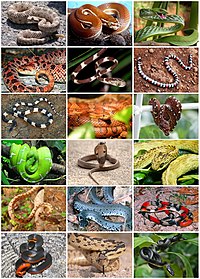
Spatio-temporal variation in environmental features predicts the distribution and abundance of Ixodes scapularis.
Sign Up to like & getrecommendations! Published in 2020 at "International journal for parasitology"
DOI: 10.1016/j.ijpara.2020.10.002
Abstract: Many species have experienced dramatic changes in both geographic range and population sizes in recent history. Increases in the geographic range or population size of disease vectors have public health relevance as these increases often… read more here.
Keywords: geographic range; disease; abundance; temporal variation ... See more keywords

A historical snapshot of Ixodes scapularis-borne pathogens in New Jersey ticks reflects a changing disease landscape.
Sign Up to like & getrecommendations! Published in 2018 at "Ticks and tick-borne diseases"
DOI: 10.1016/j.ttbdis.2017.12.009
Abstract: Historical specimens, when available, can provide new insight into the distribution and evolution of pathogens that may not be discernible from more recent samples. We used ticks collected from hunter-killed white-tailed deer in New Jersey… read more here.
Keywords: scapularis borne; new jersey; snapshot ixodes; jersey ... See more keywords

The role of Ixodes scapularis, Borrelia burgdorferi and wildlife hosts in Lyme disease prevalence: A quantitative review.
Sign Up to like & getrecommendations! Published in 2018 at "Ticks and tick-borne diseases"
DOI: 10.1016/j.ttbdis.2018.04.006
Abstract: Due to the ongoing expansion of Ixodes scapularis (blacklegged tick) throughout the northeastern and midwestern United States, there is need to identify the role wildlife hosts play in the establishment and maintenance of tick populations.… read more here.
Keywords: wildlife; ixodes scapularis; prevalence; lyme disease ... See more keywords

Survival and energy use of Ixodes scapularis nymphs throughout their overwintering period
Sign Up to like & getrecommendations! Published in 2019 at "Parasitology"
DOI: 10.1017/s0031182018002147
Abstract: Abstract The blacklegged tick (Ixodes scapularis) spends up to 10 months in the soil between feeding as larvae and questing for hosts as nymphs the following year. We tracked the survival and energy use of… read more here.
Keywords: ixodes scapularis; survival energy; energy use; energy ... See more keywords

A comparative evaluation of northern and southern Ixodes scapularis questing height and hiding behaviour in the USA
Sign Up to like & getrecommendations! Published in 2020 at "Parasitology"
DOI: 10.1017/s003118202000147x
Abstract: Abstract Ticks display a distinct type of host-seeking behaviour called questing. It has been proposed that the questing behaviour of Ixodes scapularis explains the geographic variation in Lyme disease (LD) risk in the eastern USA… read more here.
Keywords: questing height; ixodes scapularis; hiding behaviour; evaluation northern ... See more keywords

Artificial Accumulation of Leaf Litter in Forest Edges on Residential Properties via Leaf Blowing Is Associated with Increased Numbers of Host-Seeking Ixodes scapularis (Acari: Ixodidae) Nymphs
Sign Up to like & getrecommendations! Published in 2020 at "Journal of Medical Entomology"
DOI: 10.1093/jme/tjaa033
Abstract: Abstract We examined whether routine fall yard maintenance, specifically depositing leaves removed from lawns and landscaping along forest margins, may increase densities of nymphal Ixodes scapularis Say and Amblyomma americanum (L.) ticks within these managed… read more here.
Keywords: leaf litter; residential properties; edge; leaf blowing ... See more keywords

Evidence for Vertical Transmission of Babesia odocoilei (Piroplasmida: Babesiidae) in Ixodes scapularis (Acari: Ixodidae).
Sign Up to like & getrecommendations! Published in 2021 at "Journal of medical entomology"
DOI: 10.1093/jme/tjab074
Abstract: Limited evidence suggests that the cervid parasite, Babesia odocoilei, is transovarially transmitted from adult female Ixodes scapularis Say to offspring. The prevalence of B. odocoilei in unfed larval I. scapularis and whether vertical transmission is… read more here.
Keywords: transmission; evidence; vertical transmission; babesia odocoilei ... See more keywords

Selective Host Attachment by Ixodes scapularis (Acari: Ixodidae): Tick-Lizard Associations in the Southeastern United States.
Sign Up to like & getrecommendations! Published in 2021 at "Journal of medical entomology"
DOI: 10.1093/jme/tjab181
Abstract: Questing behavior and host associations of immature blacklegged ticks, Ixodes scapularis Say, from the southeastern United States are known to differ from those in the north. To elucidate these relationships we describe host associations of… read more here.
Keywords: lizard; southeastern united; attachment; host ... See more keywords

Emergence of Ixodes scapularis (Acari: Ixodidae) in a Small Mammal Population in a Coastal Oak-Pine Forest, Maine, USA.
Sign Up to like & getrecommendations! Published in 2021 at "Journal of medical entomology"
DOI: 10.1093/jme/tjab209
Abstract: In the United States, surveillance has been key to tracking spatiotemporal emergence of blacklegged ticks [Ixodes scapularis Say (Ixodida:Ixodidae)] and their pathogens such as Borrelia burgdorferi Johnson, Schmid, Hyde, Steigerwalt & Brenner (Spirochaetales: Spirochaetaceae), the… read more here.
Keywords: white footed; scapularis; small mammal; ixodes scapularis ... See more keywords

Field Evaluations of Three Botanically Inspired Repellents Against the Blacklegged Tick, Ixodes scapularis (Acari: Ixodidae)
Sign Up to like & getrecommendations! Published in 2022 at "Journal of Medical Entomology"
DOI: 10.1093/jme/tjac111
Abstract: Abstract Three compounds synthetically-derived from botanicals sources, ethyl perillyl carbonate, geranyl isovalerate, and citronellyl cyclobutane carboxylate, were tested for repellent activity against Ixodes scapularis Say in a field trial. Tick drags were treated with the… read more here.
Keywords: evaluations three; ixodes scapularis; field evaluations; drags treated ... See more keywords

Single Mowing Event Does Not Reduce Abundance of Ixodes scapularis (Acari: Ixodidae) and Dermacentor variabilis (Acari: Ixodidae) on Recreational Hiking Trails
Sign Up to like & getrecommendations! Published in 2022 at "Journal of Medical Entomology"
DOI: 10.1093/jme/tjac164
Abstract: Abstract Nuisance and medically important ticks can be abundant in a variety of forested landscapes, including recreational parks. Strategies to reduce the abundance of host-seeking ticks in high-use areas within parks are limited. Mowing vegetation… read more here.
Keywords: reduce abundance; acari ixodidae; mowing event; ixodes scapularis ... See more keywords